We put the Samsung Galaxy S24 Ultra through our rigorous SBMARK Display test suite to measure its performance across six criteria. In the results of this test, we will analyze how it performed in a series of tests and in several common use cases.
Overview
Key Display Specifications:
- 6.8-inch Dynamic AMOLED 2X (screen-to-body ratio ~88.9%)
- Dimensions: 162.3 x 79.0 x 8.6 mm (6.39 x 3.11 x 0.34 inches)
- Resolution: 1440 x 3120 pixels, (density ~505 ppi)
- Aspect ratio: 19.5:9
- Refresh rate: 120Hz
Pros
- Good readability in sunlight thanks to a very high peak brightness
- Improved management of screen reflections, thanks to advanced glass technology
- Accurate color rendering in most lighting environments
- Excellent handling of frame discrepancies when watching all types of videos or playing video games
Against
- Excessively high brightness levels in video performance
- Lack of brightness and detail in the interior lighting environment
- Poor management of inadvertent touches
The Samsung Galaxy S24 Ultra’s screen performance earned the flagship device the overall top spot in our display protocol ranking, thanks to marked improvements in almost every attribute, especially compared to its predecessor, the S23 Ultra.
In terms of readability, the S24 Ultra was just shy of achieving the maximum score with its impressive performance in harsh environments. In our tests under sunlight, the device achieved a measured peak brightness of 2572 nits (close to the advertised 2600), which is significantly higher than the Galaxy S23 Ultra’s 1750 nits. Additionally, the addition of anti-reflective glass serves to deepen contrast to make images more vivid in challenging conditions. These combined performances mean that in direct sunlight it is not necessary to find a shaded area or cover the screen with your hand to be able to see and read what appears on the display. While performance was great outdoors, screen brightness could be a bit inaccurate in other conditions: Our test results showed that screen brightness could sometimes be too high at night and too low in indoor environments. interior.
The Samsung Galaxy S24 Ultra’s color fidelity and performance were much better than the S23 Ultra’s, particularly outdoors where the S24 Ultra corrected its predecessor’s lack of color cast, but still remained a bit ‘ behind the maximum score. Additionally, viewing the screen at an angle would show a slight shift towards pink and green.
Motion performance earned a top score for the S24 Ultra thanks to the excellent way it handled frame discrepancies during video playback. Furthermore, the display would adapt its refresh rate to that of the video frame rate, thus avoiding vibrations.
The S24 Ultra was supposed to provide a very similar video experience to its predecessor, but that wasn’t the case. The S24 Ultra wasn’t able to achieve the S23 Ultra’s better performance in videos mainly because the screen was too bright to comfortably view content in a low-light environment.
The device’s redesigned edged display likely contributed to improvements over the S23 Ultra in terms of haptic interactions and accuracy, although there were occasions of unintentional touches when playing video games. Scrolling the web and viewing the gallery were smooth experiences overall. Touch responsiveness is also slightly increased compared to the S23 Ultra, which was already quite good.
Test summary
About SBMARK display tests: For scoring and analysis in our smartphones and other display reviews, SBMARK engineers perform a series of objective and perceptual tests under controlled laboratory and real-life conditions. Please note that we evaluate display attributes using only the device’s built-in display hardware and its still image (gallery) and video apps with default settings. (For in-depth information on how we evaluate smartphones and other displays, see our articles “How SBMARK Tests Display Quality” and “A Closer Look at SBMARK Display Tests.”
The following section brings together key elements of our comprehensive testing and analysis performed in SBMARK laboratories. Detailed performance evaluations in the form of reports are available upon request. Do not hesitate to contact us.
How the display readability score is composed
Readability evaluates the ease and comfort with which users can read fixed content (photos and web) on the display in various real-life conditions. SBMARK uses its display stand to recreate ambient light conditions ranging from total darkness to bright sunlight. In addition to laboratory tests, perceptual analysis is also carried out in real-life environments.
Readability in an indoor environment (1000 lux).

From left to right: Samsung Galaxy S24 Ultra, Samsung Galaxy S23 Ultra, Apple iPhone 15 Pro Max, Google Pixel 8 Pro
(Photo for illustrative purposes only)
Readability in an outdoor environment (20,000 lux).

From left to right: Samsung Galaxy S24 Ultra, Samsung Galaxy S23 Ultra, Apple iPhone 15 Pro Max, Google Pixel 8 Pro
(Photo for illustrative purposes only)
Readability in a sunny environment (>90,000 lux).

From left to right: Samsung Galaxy S24 Ultra, Samsung Galaxy S23 Ultra, Apple iPhone 15 Pro Max, Google Pixel 8 Pro
(Photo for illustrative purposes only)
Readability at a 45° angle


From left to right: Samsung Galaxy S24 Ultra, Samsung Galaxy S23 Ultra, Apple iPhone 15 Pro Max, Google Pixel 8 Pro
(Photo for illustrative purposes only)
Measurement of luminance uniformity
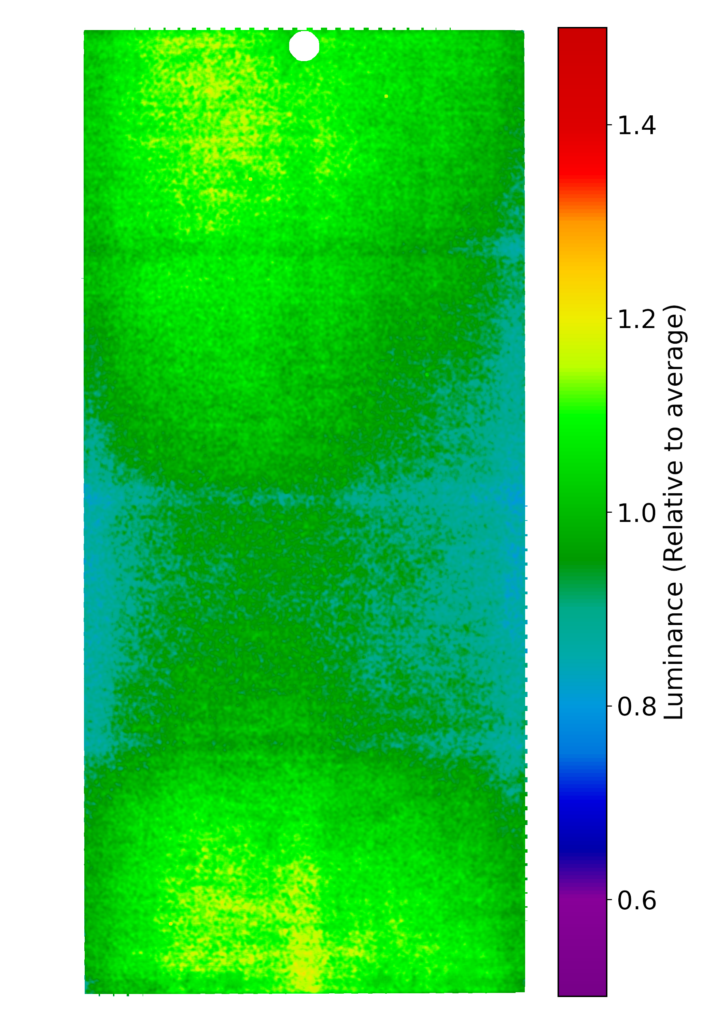
This graph shows display uniformity with a gray pattern at 20%. The more visible the green color, the more uniform the display will be.
How the display color score is composed
The color attribute evaluates the device’s ability to accurately reproduce colors. The measurements taken concern fidelity, white point color and gamut coverage. We perform color evaluations for different lighting conditions to see how well the device can handle color in its surroundings. Colors are measured using a spectrophotometer in a controlled lighting environment. The perceptual analysis of the color rendering takes place compared to the reference model displayed on a calibrated professional monitor.
White point under D65 illuminant at 1000 lux
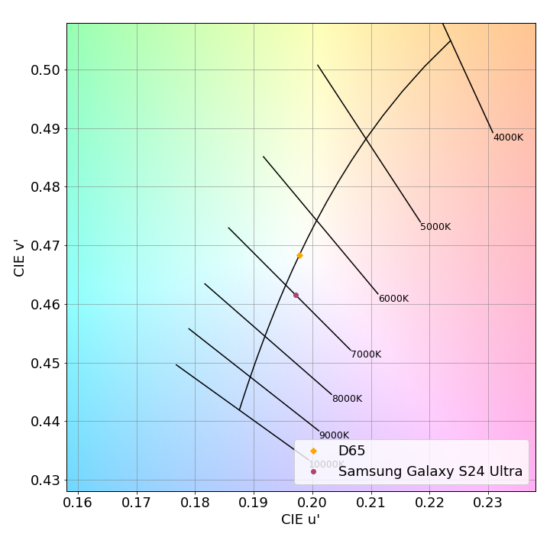
Indoor color rendering (1000 lux)

Clockwise from top left: Samsung Galaxy S24 Ultra, Samsung Galaxy S23 Ultra, Apple iPhone 15 Pro Max, Google Pixel 8 Pro
(Photo for illustrative purposes only)
Outdoor color rendering (20,000 lux)
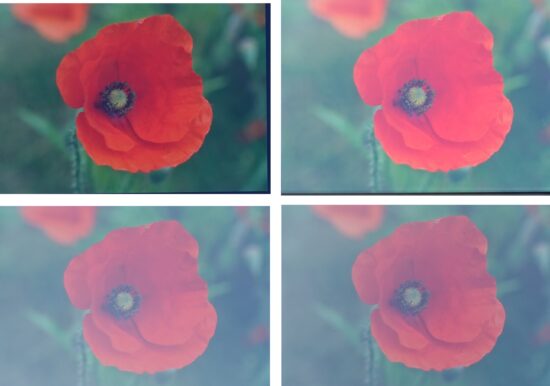
Clockwise from top left: Samsung Galaxy S24 Ultra, Samsung Galaxy S23 Ultra, Apple iPhone 15 Pro Max, Google Pixel 8 Pro
(Photo for illustrative purposes only)
Color rendering in sunlight (>90,000 lux)
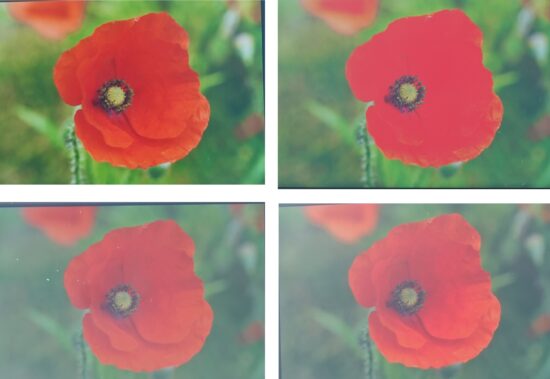
Clockwise from top left: Samsung Galaxy S24 Ultra, Samsung Galaxy S23 Ultra, Apple iPhone 15 Pro Max, Google Pixel 8 Pro
(Photo for illustrative purposes only)
Color fidelity measurements
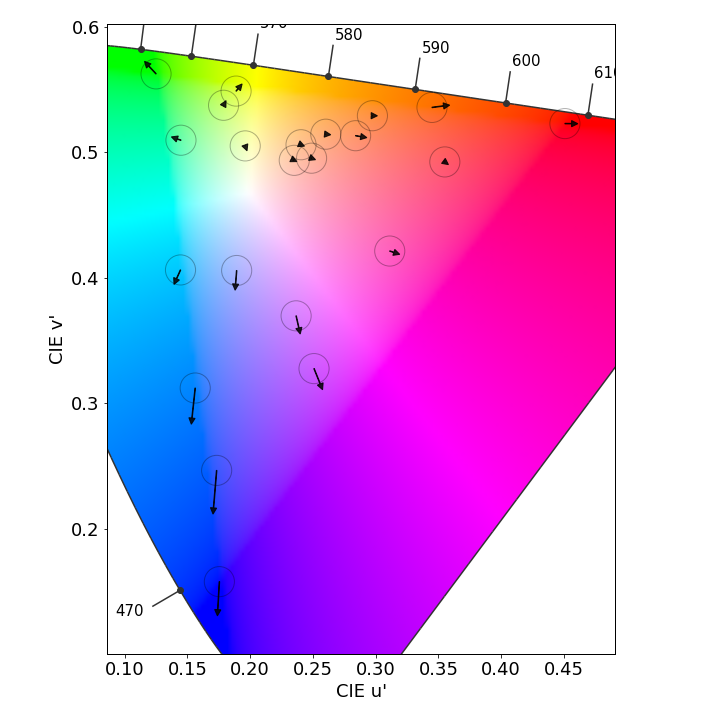
Samsung Galaxy S24 Ultra, color fidelity at 1000 lux in the sRGB color space
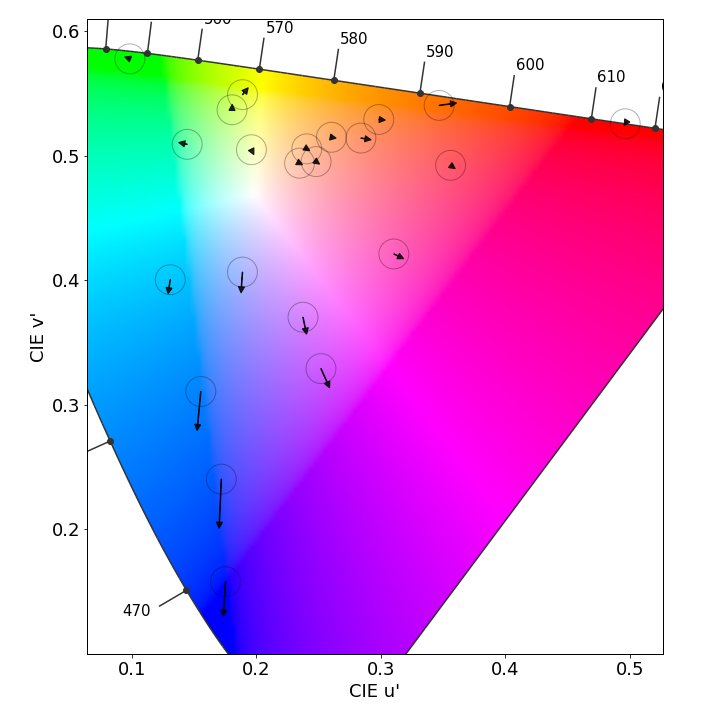
Samsung Galaxy S24 Ultra, color fidelity at 1000 lux in the Display-P3 color space
Each arrow represents the color difference between a target color model (arrow base) and its actual measurement (arrow tip). The longer the arrow, the more visible the color difference. If the arrow remains inside the circle the color difference will only be visible to expert eyes.
Color behavior on the corner
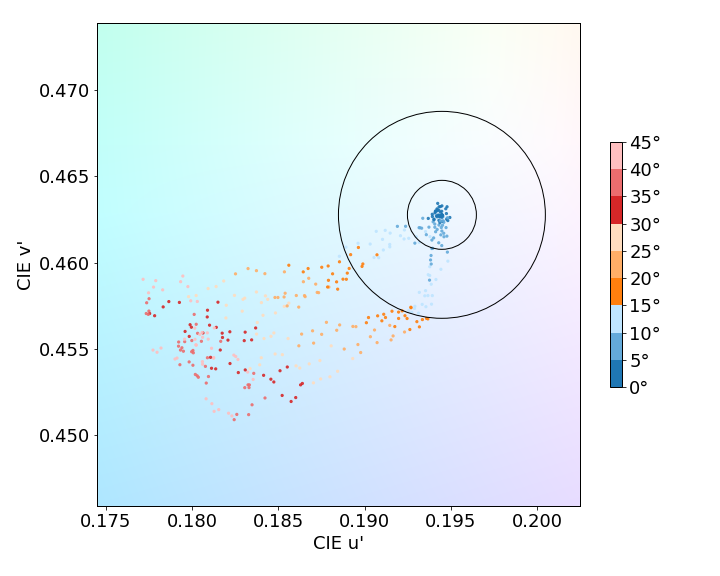
This graph shows the color shift when the screen is tilted. Each point represents a measurement at a particular angle. The dots inside the inner circle show no color change in the corner; those between the inner and outer circles have changes that only trained experts will see; but those that fall outside the outer circle are noted.
Color shift on the corner


From left to right: Samsung Galaxy S24 Ultra, Samsung Galaxy S23 Ultra, Apple iPhone 15 Pro Max, Google Pixel 8 Pro
(Photo for illustrative purposes only)
How the Display Video score is composed
Our video attribute evaluates each device’s Standard Dynamic Range (SDR) and High Dynamic Range (HDR10) video handling in indoor and low-light conditions. We measure the tone mapping, color gamut, brightness and contrast of the display. We perform perceptual analysis Cons our professional reference monitor (Sony BVM-HX310) to ensure rendering meets artistic intent.
Video rendering in a low light environment (0 lux).

Clockwise from top left: Samsung Galaxy S24 Ultra, Samsung Galaxy S23 Ultra, Apple iPhone 15 Pro Max, Google Pixel 8 Pro
(Photo for illustrative purposes only)
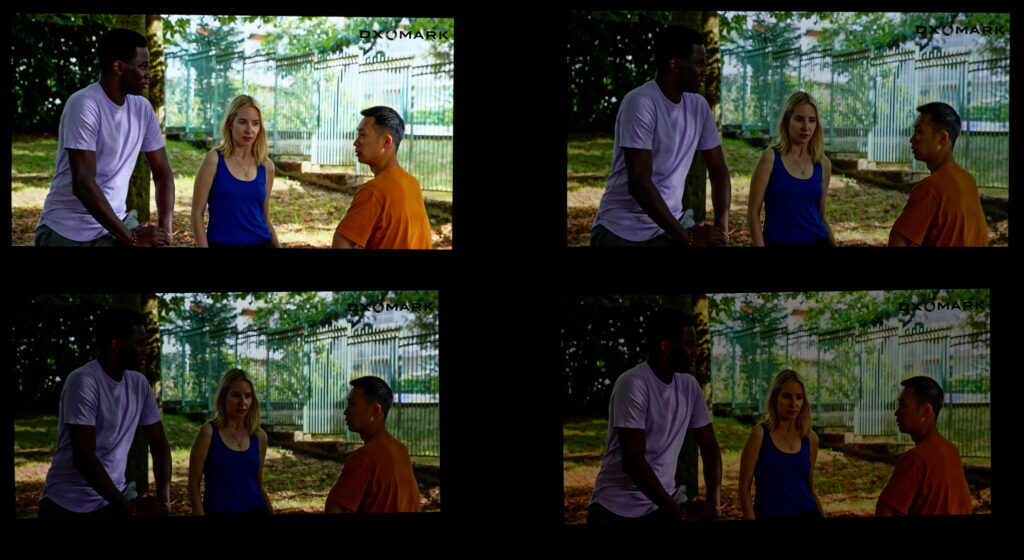
Clockwise from top left: Samsung Galaxy S24 Ultra, Samsung Galaxy S23 Ultra, Apple iPhone 15 Pro Max, Google Pixel 8 Pro
(Photo for illustrative purposes only)
Gamut coverage for video content


Primary colors are measured in both HDR10 and SDR. The extracted color gamut shows the extent of the color area that the device can reproduce. To meet artistic intent, the measured gamma must match the primary color space of each video.
How the Display Motion Score is composed
The motion attribute evaluates dynamic content handling. Dropped frames, motion blur, and playback artifacts are examined using games and videos.
Dropped video frames
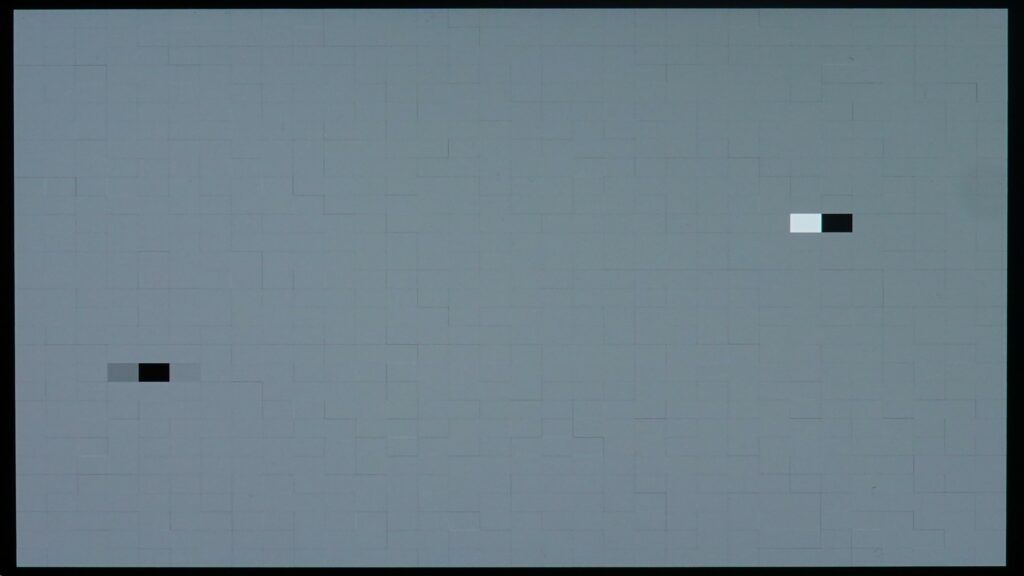
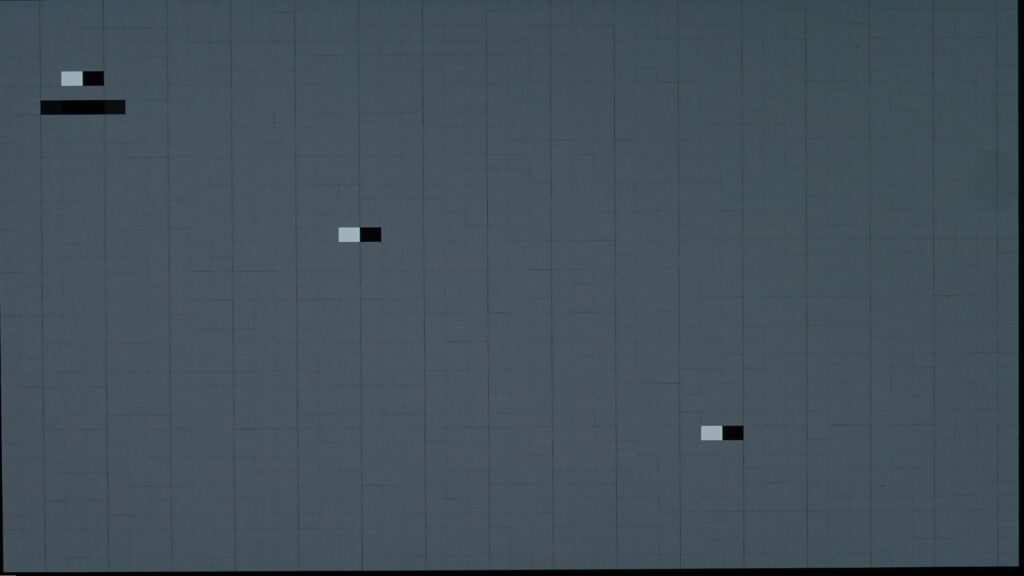
These long exposure photos have the number of frame irregularities in a 30 second video. Good performance shows a regular pattern (a flat gray image or a drop-down pattern).
How the Display Touch score is composed
To evaluate touch, SBMARK uses a touch robot and a high-speed camera to play and record a series of scenarios for evaluating smoothness, accuracy and response time.
This response time test accurately evaluates the time that elapses between a single touch of the robot on the screen and the displayed action. This test is applied to activities that require high responsiveness, such as gaming.
How the display artifact score is composed
Evaluating artifacts means checking for performance, image rendering, and motion defects that can impact the end-user experience. SBMARK precisely measures device reflectance and the presence of flicker, and evaluates the impact of residual aliasing when playing video games, among other features.
Aliasing (foreground)

Samsung Galaxy S24 Ultra
(Photo for illustrative purposes only)

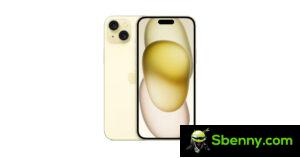
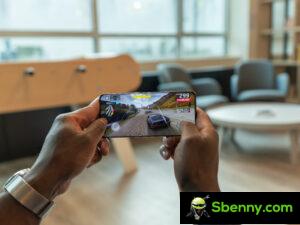
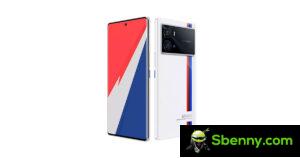
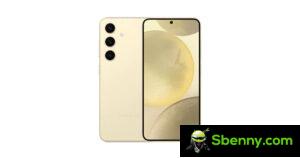
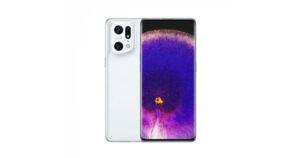
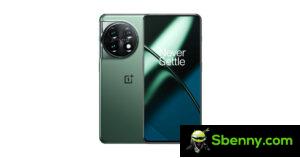
Start a new Thread